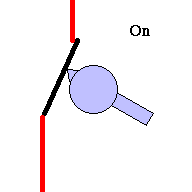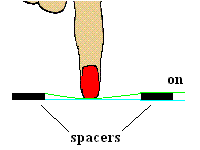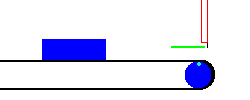

This is how your computer knows what key you pressed.
Key Terms
actuator
sensor
We have five senses to help us interact with the world - touch, sound, smell, taste and sight. These are our sensors. We use them as input devices to gather information. Our body converts the data they receive into chemical and electrical signals which are processed by the brain. We use our hands, feet and voice to manipulate the world ... these are our actuators. Sensors are input devices which gather information and actuators are output devices which manipulate (act on) things.
We have surrounded ourselves with machines and devices that do the same thing. That is, they are able to gather information about the world (sensors) and then interact somehow with the world ... manipulating it (actuator). One can claim that these contraptions do a much better job than humans because they are much more reliable, give more detailed information and are unbiased. In fact, these mechanical devices can detect and measure things which are beyond our human senses. For example, can you tell the strength and orientation of magnetic fields? What is the level of carbon monoxide in your home right now? Which house in your neighborhood is best insulated? Sensors (and actuators) are all around us. A few examples are:
- Digital thermometers will tell you whether you have a fever.
- Water comes out of the restroom faucet when you put your hands under the tap.
- A warning light tells you if your car is running low on gas.
- Your camera adjusts to the proper light levels to make sure your pictures come out perfect.
- Your sump pump goes on when water levels get too high.
- An alarm sounds when a burglar enters your house.
- You know your turkey is done when a plastic rod pops up.
- The smoke alarm goes off when you burn the toast.
- Your car shifts gears when the (automatic) transmission reaches a certain RPM.
- The Clapper® turns lights on and off (and makes a fine Christmas gift).
As you work through this class we will cite many examples of sensors and actuators and how they work. In the process, you will learn some interesting science (hopefully). This is because many of the sensors and actuators we will discuss rely on the physical properties of materials and how they are altered in response to changes in temperature, stress, electric and magnetic fields, radiation, etc. Learning science with this approach should be more fun and interesting than the "traditional method" and much more relevant because you will be investigating devices you use and see everyday.
Specifically, sensors need to be able to inform us about:
It will be fun (I hope) to see the many ways sensors are able to answer some of these questions. Since most modern sensors rely on electrical systems, we really can't do service to this topic now ... but we will. For now, let me give you just a few ways "older" generations dealt with some of these problems:
Temperature - Use a simple mercury thermometer. The liquid
expands (up a tube) as it gets hotter.
Even the chirping
of a cricket (link
2.1.a) can give temperature.
Humidity - The length of a human
hair (link
2.1.b) actually changes with humidity levels.
Forces - A simple spring will stretch according to the applied force.
Did you ever weigh a fish with a simple spring scale?
Presence of Chemicals - Chemists used (and still do) litmus paper to see
if a solution is acid or base. Depending on the color, you could judge the
level of pH.
Magnetic Field - Get a compass!
Position - If an object rested in the correct place, it would activate a
simple switch which would either open or close an electrical circuit. OK
... so this is electrical. However, it is so simple that it allows us to
move to the next topic - actuators.
It is important to realize that most complicated machines or utensils use several component parts (subsystems) which work together to make the item work properly. Each subsystem may deal with a different realm of science. For example, if you wanted to understand how a car works you would have to learn about thermodynamics to understand the engine, electricity to understand the ignition system, and chemistry to understand the battery. Or even then, you still have more independent discussions dealing with fuel gauges, wiper blades, power windows and locks, braking system, cooling system, etc. You would be surprised how much interesting science you could learn just by studying your car! So when we investigate devices in this class, we will make every attempt to isolate the essential subsystem of a device and deal with the one aspect of science you need to understand to be able to say ... "I know how this thing works!"
So where do you start???? Start simple!
The OFF / ON Switch
An off/on switch is any device that opens and closes an electric circuit. Here we will only look at the switch, not where the electricity goes or what it is used for. You would be surprised how many interesting ways people have come up with to accomplish one thing ... turn things on and off. Probably the simplest controlling on/off device is the manual switch. We use switches to turn on/off lights, power up computers, and just about anything electrical requires you to press a button or flip a switch to get it going.
|
|
This is how your computer knows what key you pressed. |
(animation)
Almost everything electrical has an on/off switch. Sometimes it is in the form of a button (that stays on or off after you press it). That on-off button works similar to the system a ball point pen uses to open/close the pen tip - wedges (covered in unit 1 - simple machines).
Most assembly lines (and other applications of robotics) need to know when an item is in the proper position. A simple "end switch" may be all you need. The animation below shows how that works.

An end switch (animation)
One simple twist on this manual on/off switch is accomplished by using magnets (or electromagnets). A magnetic reed switch is illustrated below. As the animation shows, when a magnet gets close to the switch, it allows an electrical connection.

(animation)
This is a simple way of signaling an alarm when someone opens a door or window. These switches are operated manually. As you will soon see, there are many clever (electrical) ways to open and close a switch when nobody is even around.
Sometimes ... timing is everything!
Many devices use timers as switches to control when something should happen. Timers can be found in dishwashers, water softeners, washing machines, frost free refrigerators (timers are used to activate the defrost cycle), etc. The distributor in your (older) car "times" when to fire the spark plug. These mechanical timers are very simple switching devices, but very important tools to make the device work properly.
They act much like the old time music boxes (link 2.1.c) that would chime out a tune. Basically, a small motor would spin and tiny cogs or cams would lift contacts ... opening and closing circuits at regular intervals.
We have only scratched the tip of the iceberg. As we progress in this course, we will revisit this topic and introduce many clever ways to flip switches, apply forces, give information, etc. The key is to use sensors to gain information about the real world and activate actuators to manipulate something.
©2001, 2004, 2007, 2009, 2016 by Jim Mihal - All rights reserved
No portion may be distributed without the expressed written permission of the author